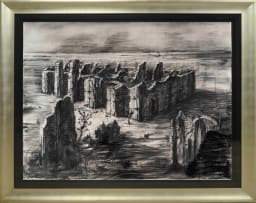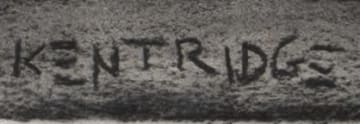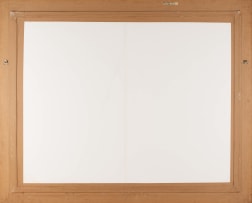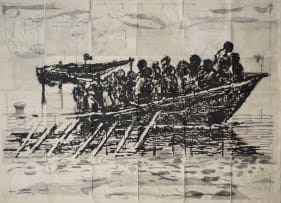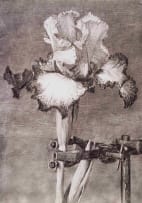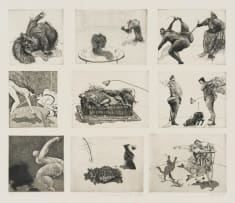William Kentridge
Untitled, Drawing for Il Ritorno d'Ulisse
About this Item
signed
Notes
Depicting the ruins of the Baths of Caracalla in Rome, this drawing was one of roughly 40 that William Kentridge made for the very first opera he directed, Il Ritorno d'Ulisse, commissioned by the organisers of the Kunsten Festival des Arts in Brussels in 1998.1 The opera followed straight after the first seven hugely successful video animation films, the well-known Soho Chronicles.2 The drawing would have been digitised and screened as a backdrop for the stage on which the opera performance took place. 'Images shifted from pastoral glades to urban waste, from ruined ancient cities to office buildings being demolished.'3
The story told in the opera is that of the larger-thanlife character from Homer's Iliad, Ulysses, on his return from the ten-year Trojan War and another ten years of (not) finding his way home. It focuses specifically on him fending off his wife Penelope's three suitors, she under the impression that Ulysses was long dead. The production was based on the musical score of the Claudio Monteverdi opera composed in 1641, with the libretto written by Giacone Bardoaro.
Kentridge devised a highly innovative design for the opera: centre stage was semi-circled by a very steep, stepped anatomy-theatre-like structure on which the chorus and soloists were positioned. They overlooked the 'anatomical dissection' of the main character, Ulysses, lying prostrate on an old metal gurney from a Joburg hospital. The drawings projected against the back wall represented Ulysses' subconscious. All the characters, including Ulysses, are puppets, designed by the Handspring Puppet Company, whose services Kentridge had previously employed for other creative works.4 Each character was played by three entities: the puppet, the puppeteer/manipulator, and the singer, making directing the opera a highly challenging and complex affair. Kentridge, struck by the agency of the puppets, explains that this set-up was very much what life is all about - constructed of fragments forming a whole.5 He elevated opera from a minor art form (largely consisting only of costumes and decor) to a major gesamtkunstwerk, or collaborative artwork.6
The drawings reflect the characters' inner conflict. The ruins are perhaps a symbol of the lost years and perhaps suggest that his country and the lives of his people are ruined. Drawings of Piranesi-like ruins and deserted streets, depictions of decay and collapse, suggest an exterior enemy that Ulysses has to fight, juxtaposed with his interior conflict, doubts about self-worth, sense of responsibility and overwhelming emotions of failure and loss. The interior struggle is visualised in yet another set of drawings, which include x-rays, cross-sections of the brain, and sonar scans. These conflicts are ameliorated to some extent by the sprouting plant life which suggests rejuvenation and rebirth take place. Out of the ruins grows a confident young tree with young leaves. Out of drawings of Ulysses' brain scans and cross-sections of his heart grow an iris (another important motif in the Kentridge oeuvre), symbolising Penelope. The present lot is a highly significant work in Kentridge's artistic career, drawing on previous imagery and anticipating new motifs in his work. The Baths of Caracalla, built in ad 212 and operational until ad 530, also enjoyed a form of rebirth: the Rome Opera House is currently housed in the ruins. Interestingly enough, the central part of the Baths served as inspiration for the design of Pennsylvania Station in New York as well as for the design of Chicago Union Station.
1. Subsequent operas include: The Magic Flute (Mozart) 2005, The Nose (Shostakovich) 2010, Lulu (Alban Berg) 2015, Wozzeck (Alban Berg) 2017, and The Head and the Load, 2019.
2. 1989: Johannesburg, Second Greatest City after Paris; 1990: Monument; 1991: Mine; 1991: Sobriety, Obesity and Growing Old; 1994: Felix in Exile; 1996: History of the Main Complaint; 1998: Weighing … and Wanting.
3. Anthony Tommasini (2016) 'Puppets are the Stars', review of the opera, New York Times, 15 November.
4. 1992: Woyzeck on the Highveld; 1995: Faustus in Africa; 1996: Ubu and the Truth Commission; and, after Ulisse (1998); 2000: Confessions of Zeno.
5. Jane Taylor (ed) (2009) Hand Spring Puppet Company, Johannesburg: David Krut, page 179.
6. Jonathan Gilmore (2004) 'Bed and Puppet: Jonathan Gilmore on William Kentridge's Ritorno d'Ulisse', Artforum, XLII: 10, page 78.
Literature
PSK (1998) William Kentridge: Il Ritorno d'Ulisse, Brussels: PSK (Paleis voor Schone Kunsten), drawings from Kentridge's version of Monteverdi's opera, Il Ritorno d'Ulisse illustrated.


